Omo Valley: The Extraordinary Tribal People of Southern Ethiopia Photography Tour Report 2019
23 February 2019






































Wata, an Arbore elder, standing in front of piles of papyrus reeds. (Image by Inger Vandyke)

The Hamer women and girls are often considered to be some of the most photogenic people in the Omo Valley (Image by Inger Vandyke)

Hamer women wear the scars of their whipping with great pride. To them it signifies their strength and suitability for becoming a Hamer bride. (Image by Inger Vandyke)

A traditional Nyangatom girl from South Sudan. Along with numerous strands of necklaces, Nyangatom women pierce their bottom lips and insert a brass ring in them for decoration. (Image by Inger Vandyke)

A decorated girl of the Mursi tribe stands in the hills of the spectacular Mago National Park near Jinka in southern Ethiopia (Image by Inger Vandyke)

While many Nyangatom women opt for necklaces in their traditional colours of red, yellow and green, you can still occasionally meet a girl simply wearing strands of wooden beads (Image by Inger Vandyke)

A Karo boy stands waiting for livestock to be herded into an elaborately constructed enclosure in the village of Dus, the Omo Valley (Image by Inger Vandyke)

The women of the Karo decorate their hair using a combination of animal fat and red ochre. They also proudly wear numerous strands of colourful beads around their necks. (Image by Inger Vandyke)

To combat a swarm of unexpected bees, Hamer women burned coals to make smoke and keep them away. (Image by Inger Vandyke)

A young Suri boy in the Kibish area of the Omo Valley (Image by Inger Vandyke)

In the past a Nyangatom man would mark his chest with a scar each time he killed a warrior from another tribe. These days, the scars are created more for beauty than for killing prowess (Image by Inger Vandyke)
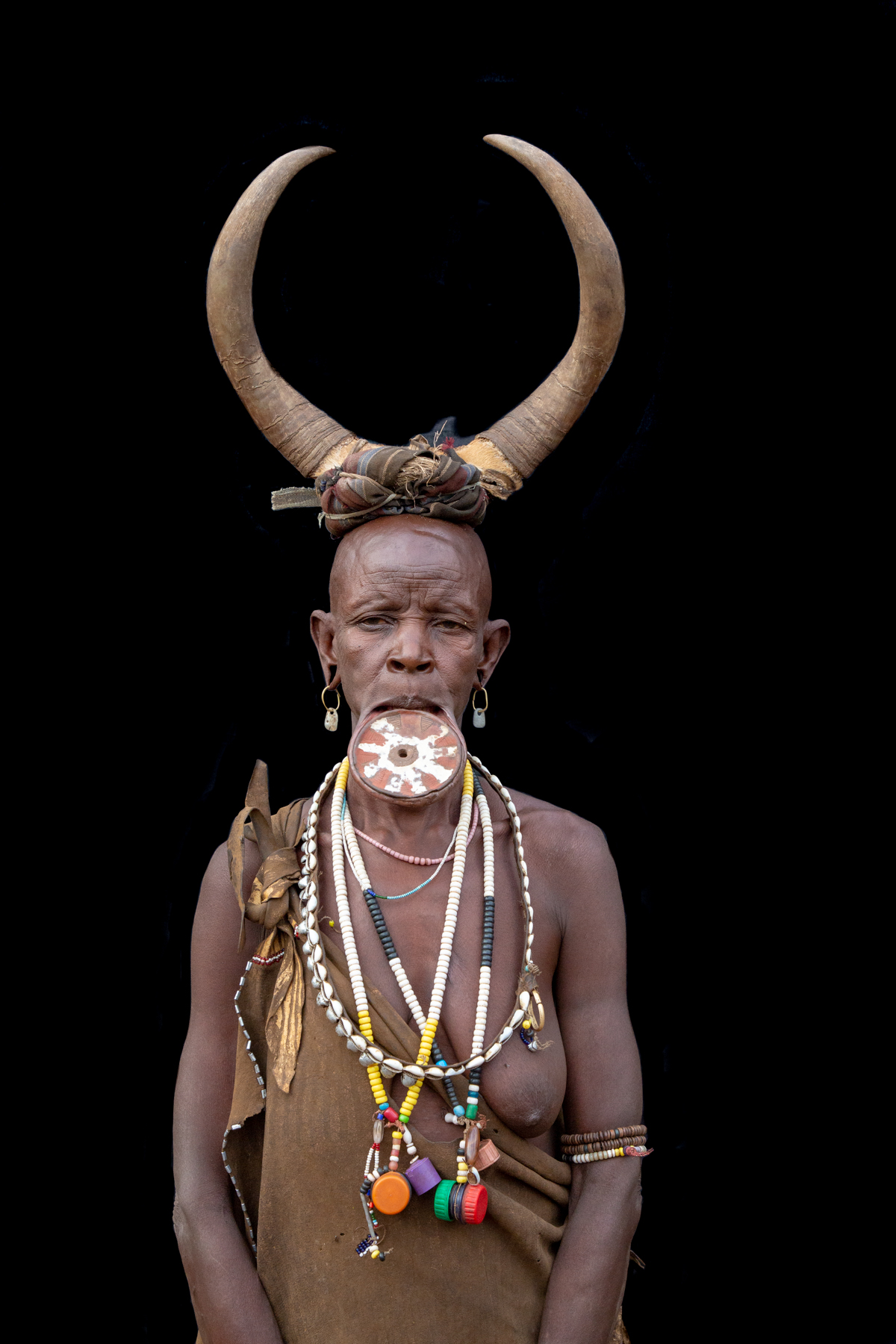
A Mursi woman wearing her signature lip disk (Image by Inger Vandyke)

Abushe. He is a young Ari boy with blue eyes, a rare genetic anomaly in African people. (Image by Inger Vandyke)
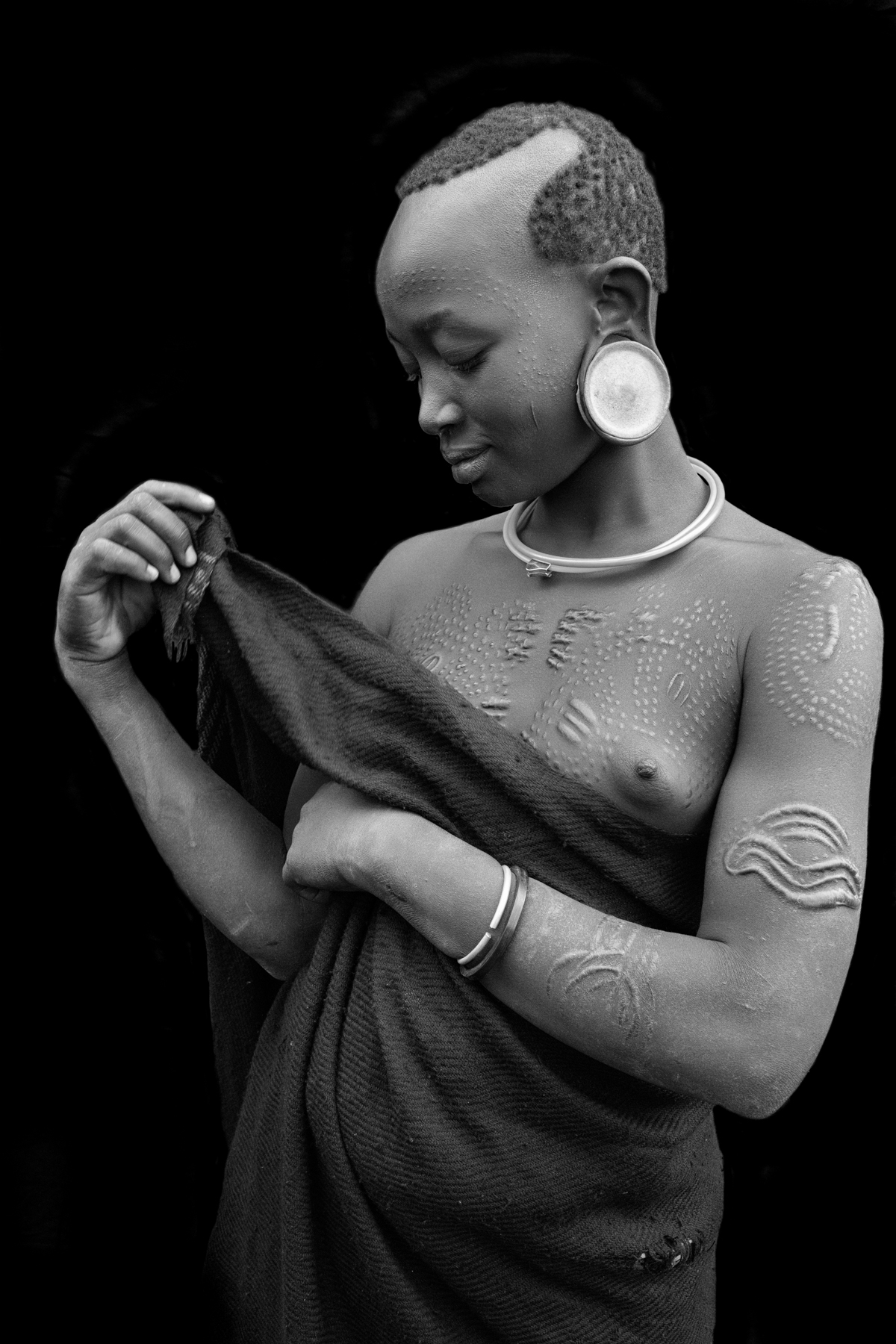
A young Suri woman shows off her beautiful body markings. (Image by Inger Vandyke)

Bagogu, a young Suri boy, smiling with his scarification and face painting (Image by Inger Vandyke)
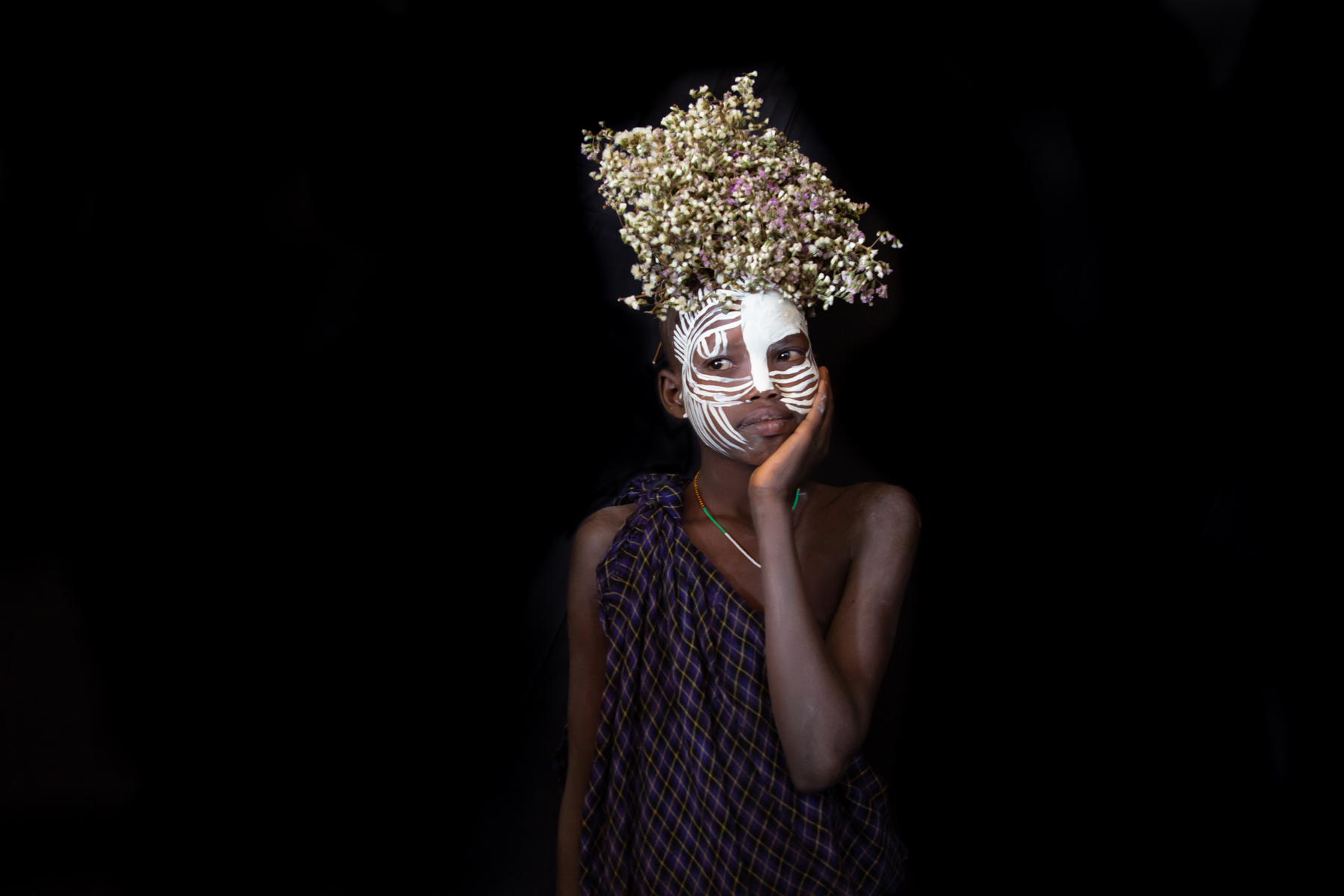
A beautiful young Suri girl near Kibish in the Omo Valley (Image by Inger Vandyke)

Holding hands in the Omo Valley. (Image by Inger Vandyke)
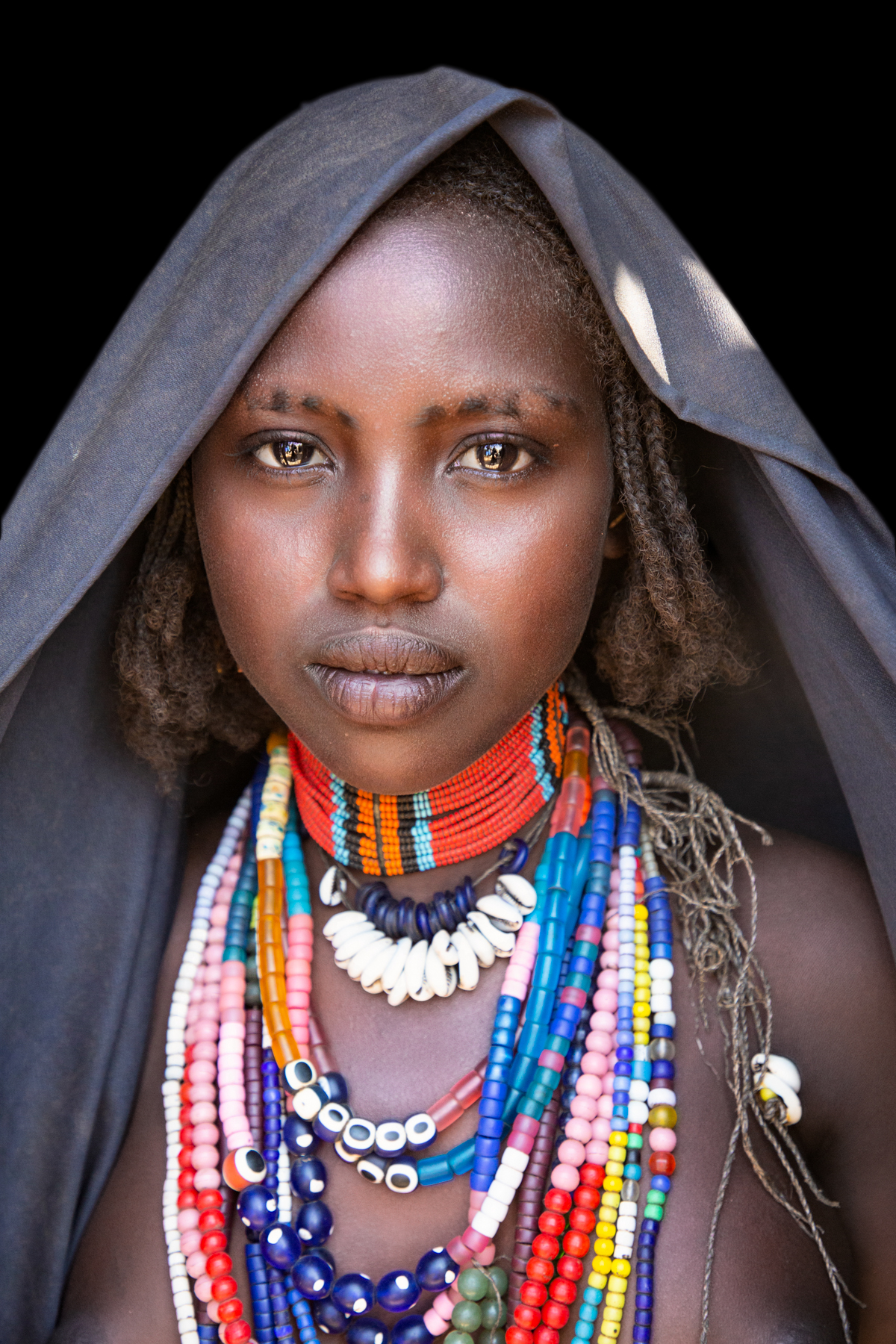
Portrait of Bariti, a beautiful Arbore girl (Image by Inger Vandyke)

A group of Karo people walk over to meet us through clouds of dust in their village of Dus. (Image by Inger Vandyke)

A cattle herder at a remote cattle camp of the Mursi people. (Image by Inger Vandyke)

An elderly Karo man holds a puppy in a toy boat he has carved out of wood (Image by Inger Vandyke)

A Mursi woman in the doorway of her hut at Mago National Park in southern Ethiopia. (Image by Inger Vandyke)

When Hamer women marry they are required to adorn their hair with a mixture of red ochre and animal fat. Prior to marriage, they may wear their hair any way they wish. (Image by Inger Vandyke)

Napokot, a traditional Nyangatom woman, outside her hut in the remote Central Rift Valley region of southern Ethiopia. (Image by Inger Vandyke)
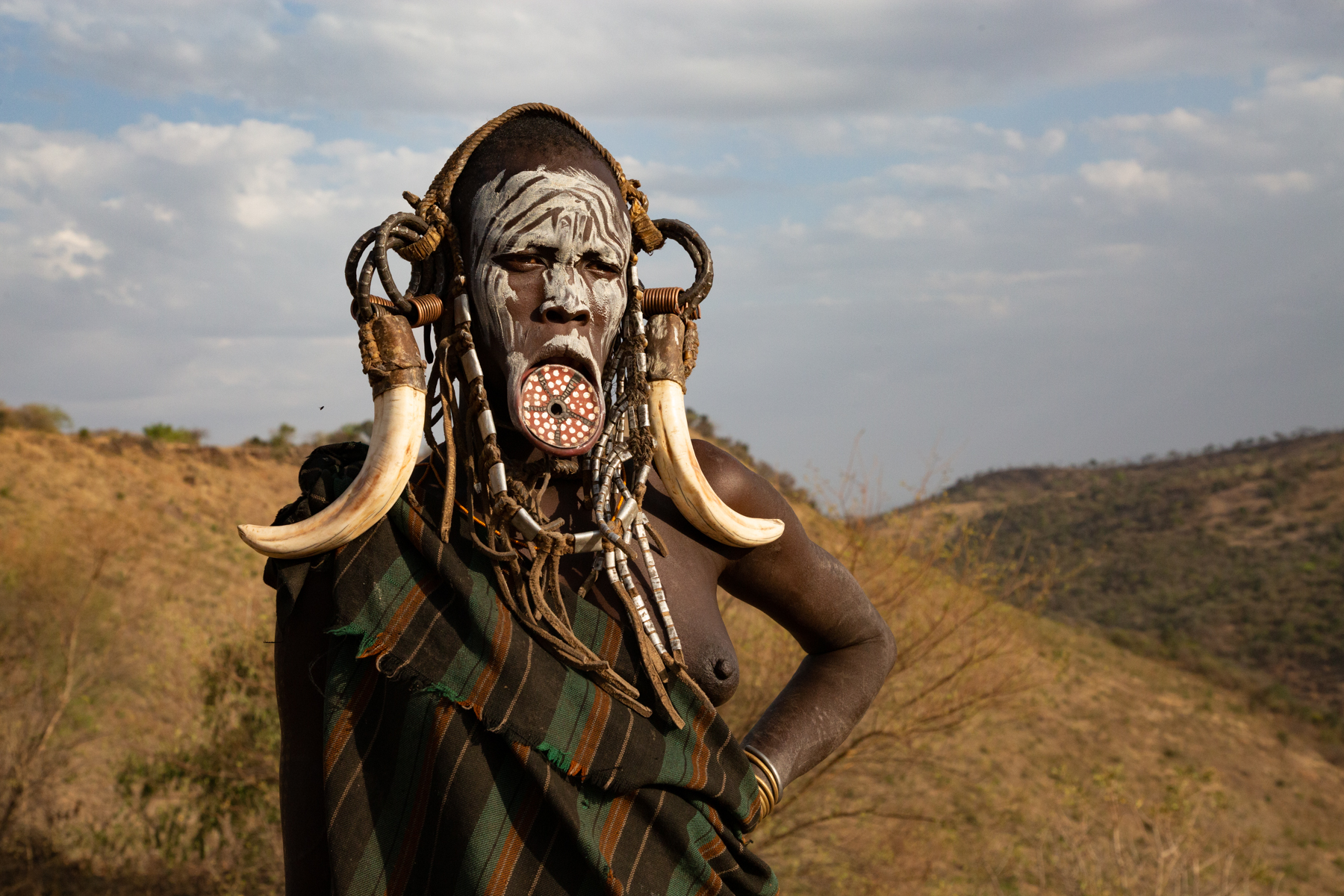
The striking appearance of a Mursi woman with her lip plate and decorations of warthog tusks in the Mago National Park (Image by Inger Vandyke)
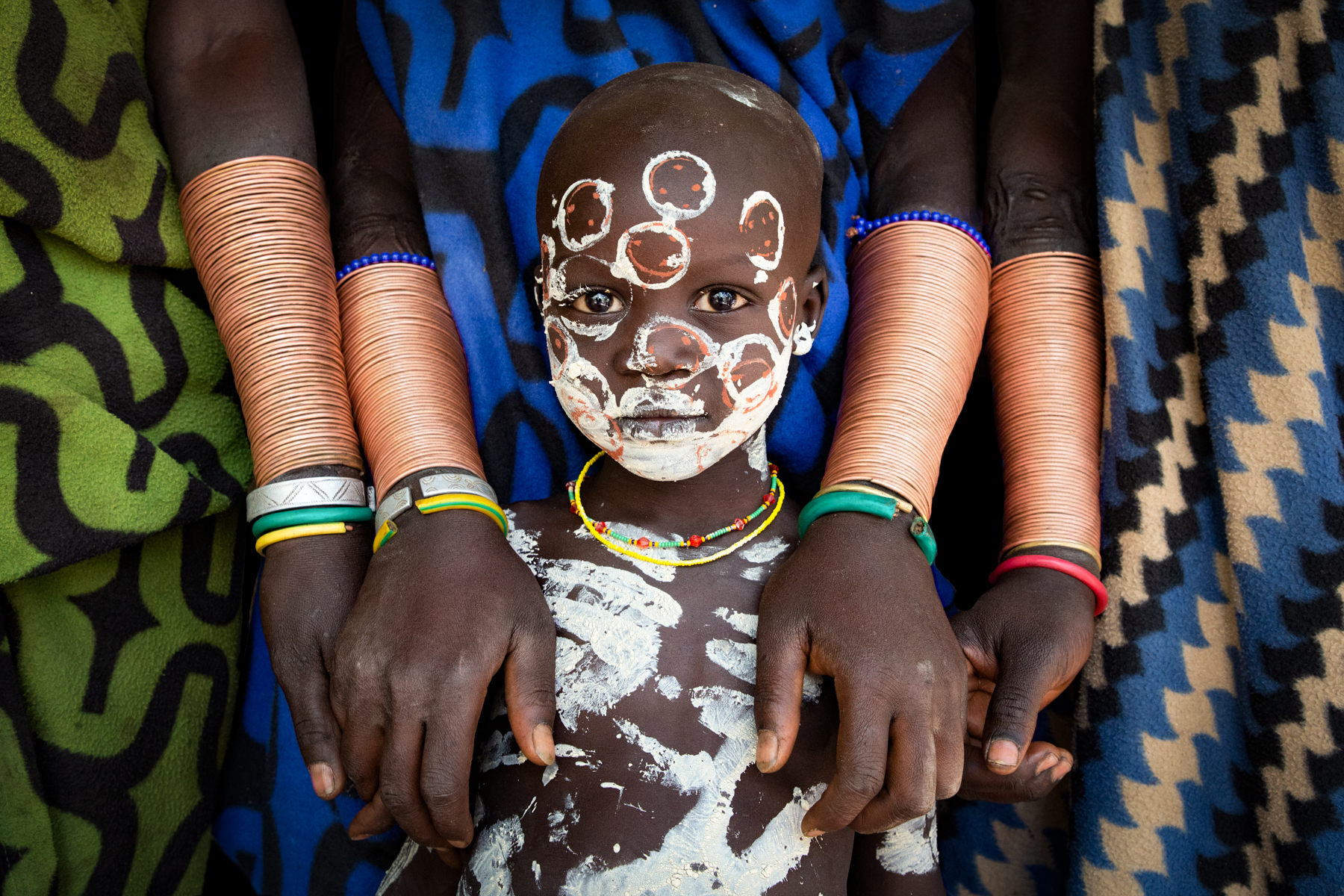
Babuku, a young Suri boy with his face painted in the more modern Suri way, surrounded by the copper bracelets worn by traditional Suri women of his tribe (Image by Inger Vandyke)

An elderly Karo lady in Dus (Image by Inger Vandyke)
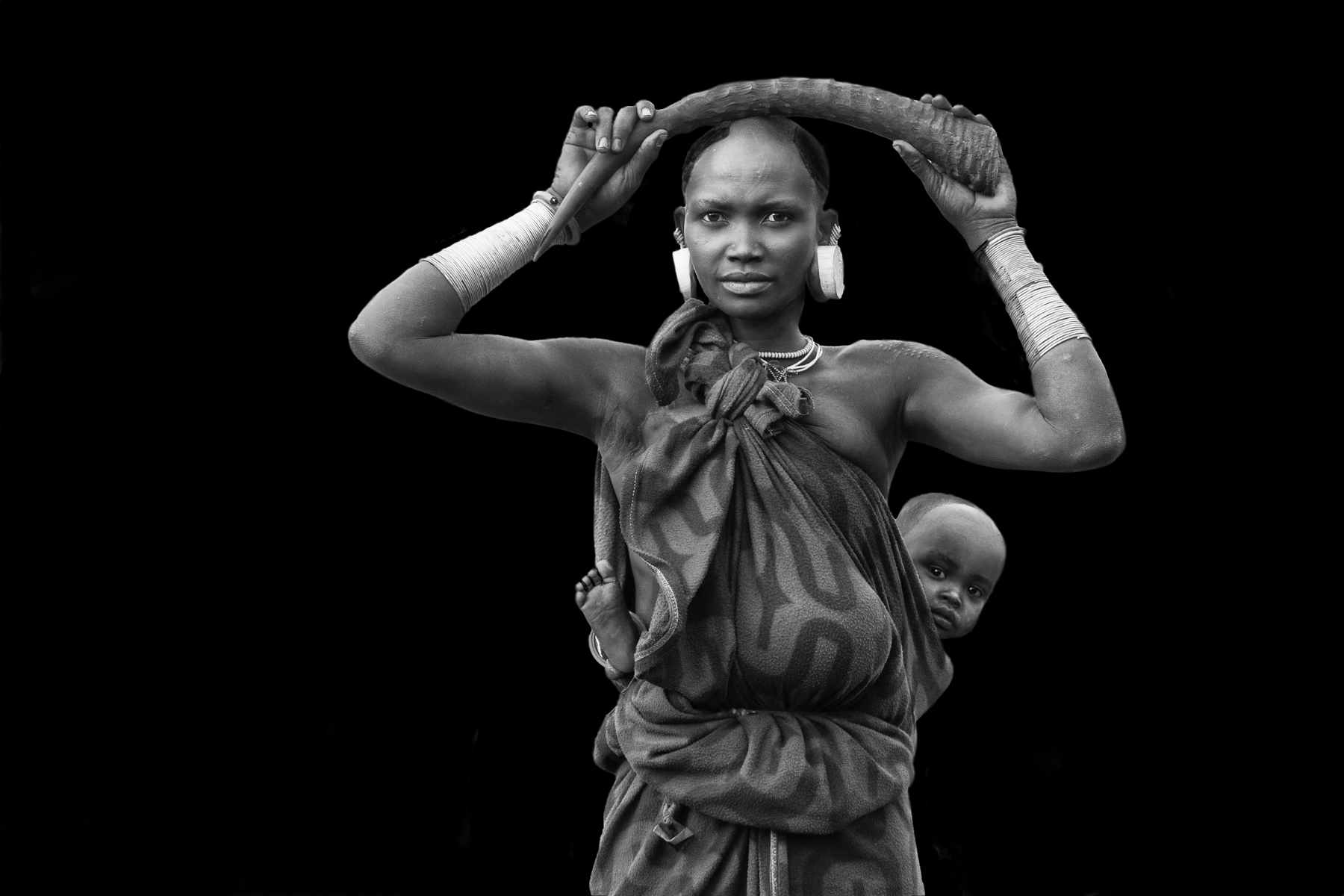
A traditional Suri woman and her baby in the Omo Valley. She is carrying the horn of a large Waterbuck on her head (Image by Inger Vandyke)

Hamer children grow up surrounded by the intricate traditional dress of their mothers. (Image by Inger Vandyke)
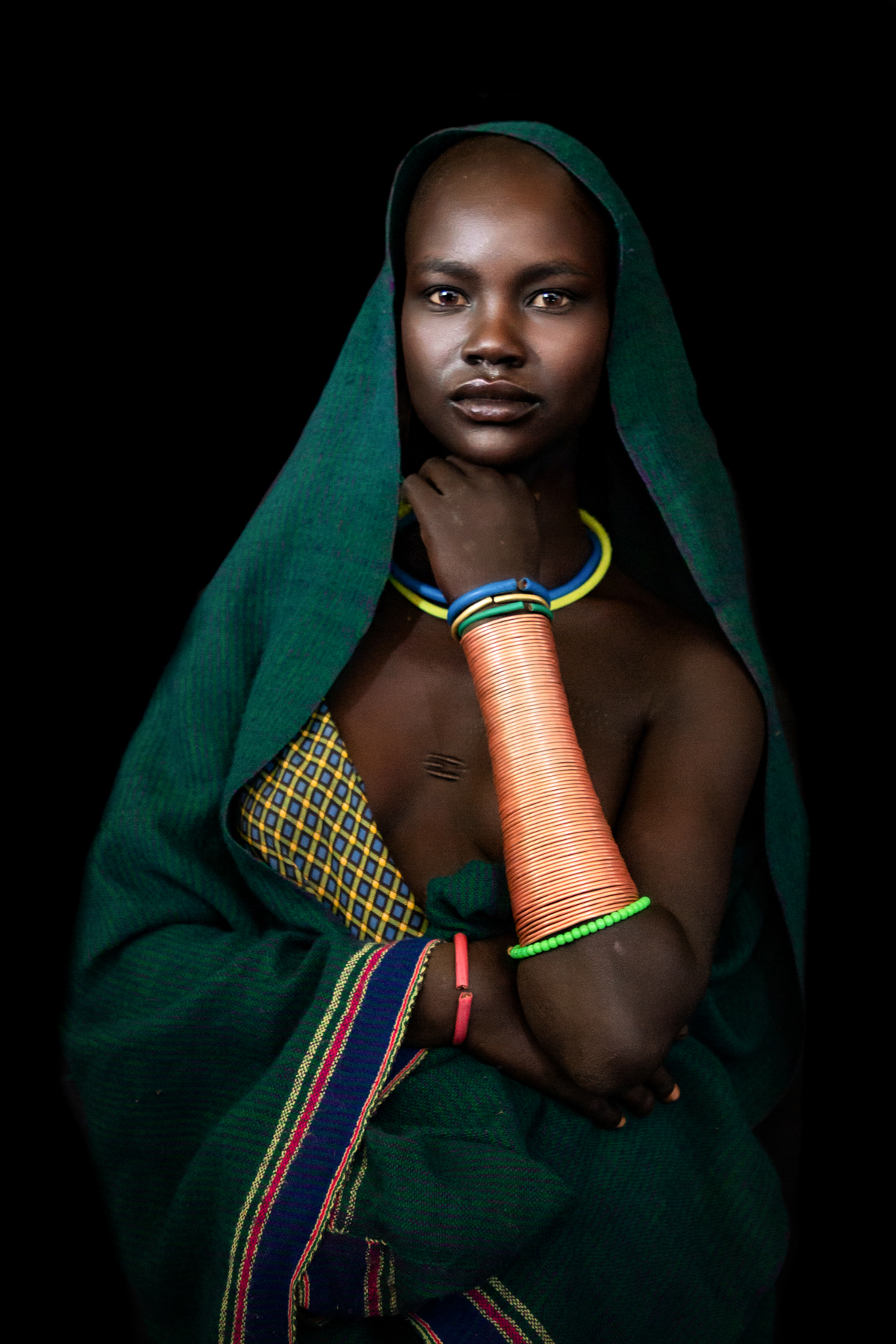
This is the real Suri. Portrait of an elegant young Suri girl with her traditional green head covering and long copper bracelets (Image by Inger Vandyke)

The delicate act of face painting in the Suri people of the Omo Valley (Image by Inger Vandyke)

Noko, one of the Karo tribal elders in Dus, the Omo Valley. He is standing in front of a Marmar, a type of parliament house building constructed by village elders for decision making. (Image by Inger Vandyke)

A young Hamer boy who is a part of the group that prepares a young initiate for his bull jumping ceremony. (Image by Inger Vandyke)
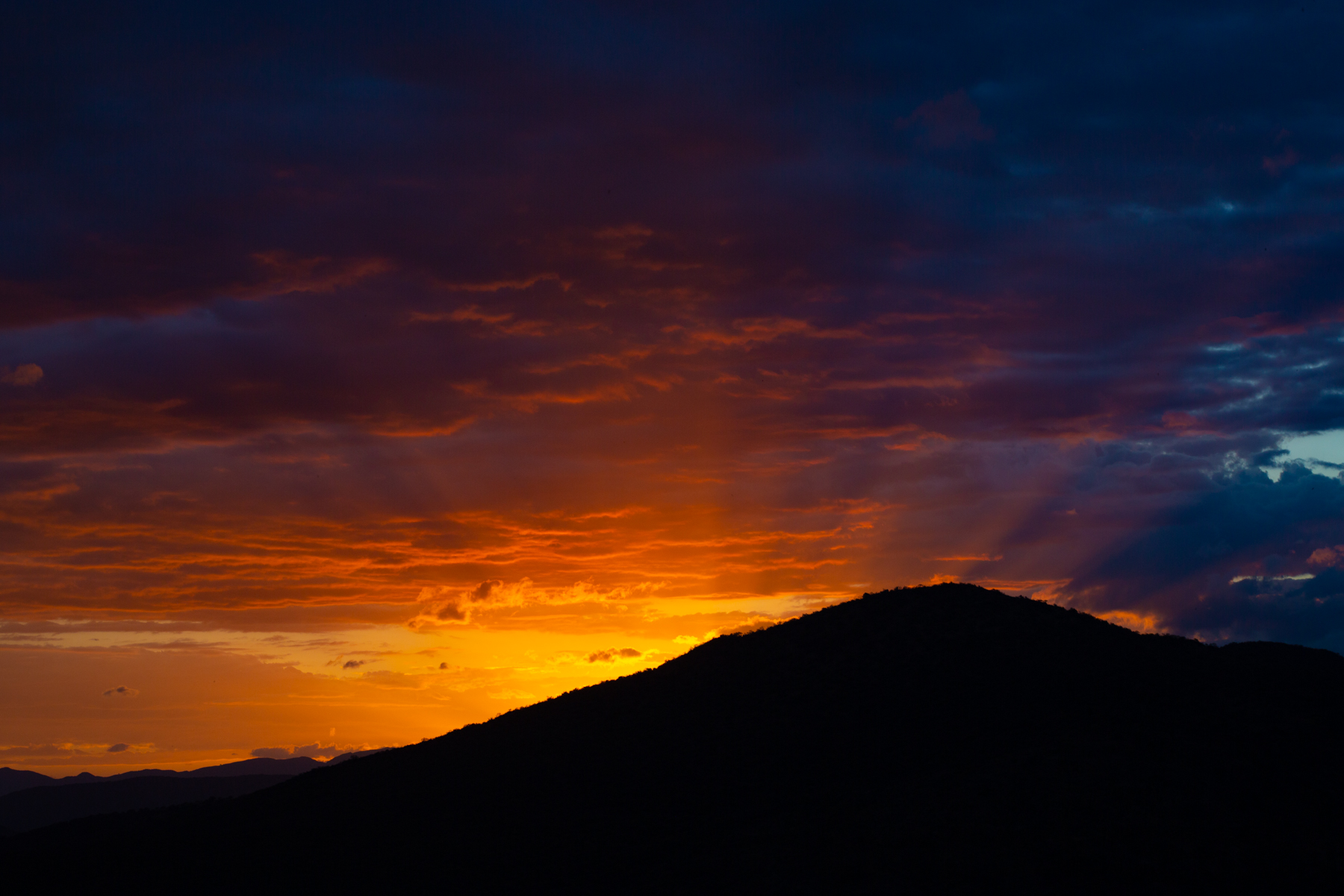
Sunrise near the beautiful Lake Chamo at Arba Minch in southern Ethiopia (Image by Inger Vandyke)

Stilt walking children of the Banna people on the road between Turmi and Jinka in southern Ethiopia (Image by Inger Vandyke)

Warriors from the Suri tribe protect themselves from serious injury in helmets and guards fashioned from plastic bottles and thread (Image by Inger Vandyke)
In February Wild Images undertook its inaugural tour to the stunning Omo Valley in southern Ethiopia. In this region if you happen to chance upon a nomadic cattle camp, the Suri stick fighting match or Donga and a Hamer Bull Jumping ceremony, you will be excessively lucky to see all three in one journey to the Omo. Through a bit of persistence, excellent local trackers and a healthy dose of good luck, we managed to see all three in one trip! Couple this tremendous luck with some unexpected excursions with the Ari people who took us on a medicinal plant walk, and the Gamo fishermen of Lake Chamo and a meeting with Abushe, the small blue-eyed boy of Jinka and we had a truly extraordinary trip to this fascinating part of the world.
Addis Ababa
Our journey started in Addis where we enjoyed a welcome dinner before a morning of excursions for photography around the city. It was a perfect introduction to Ethiopia which allowed us to familiarise ourselves with doing portrait photography in the street and we visited the oldest coffee house in Addis before we return to the hotel to collect our bags and head to the airport. Our flight to Jimma was in the afternoon and we were collected from the airport on arrival by our team who transferred us to the Dololo Hotel to start our journey south into the Omo.

Portrait of a muslim man in the Mercato of Addis Ababa (Image by Inger Vandyke)
Suri People
After a night of rest we drove south towards the remote town of Kibish in the Omo Valley. Kibish is a one street town that is the centre for the spectacular Suri people who originate from South Sudan. We arrived and set up camp before meeting with these amazing people in a local village. As the sun was setting, we photographed painted Suri children in our camp compound and we wandered around the local village chatting with Suri people and taking more photos. The light was soft. A warm African wind was blowing gently and it was an amazing start to our journey through the spectacular Omo and Central Rift valleys.

Portrait of a beautiful Suri girl near Kibish in the Omo Valley (Image by Inger Vandyke)
Walking with Suri Warriors
On our first day we heard from our tracker that a ‘Donga’ or stick fight might occur but they weren’t sure so as the days passed in the Suri region we went off to photograph both touristy Suris and many people in traditional villages while we waited. Eventually we got news that the Donga had been confirmed and we stayed an extra day in the Suri area in order to see it.
In most cases, this stick fighting is done so young men can find wives. It is a way for young men to prove themselves to the young women. To the Suri, the ideal time to stick fight is just after it rains. The fights are held between Suri clans, and the fights begin with 20 to 30 people on each side. Of these 20 to 30 people, all get a chance to fight one on one against someone from the other side. During these fights there are referees present to make sure the rules are being followed. Many stick fights end within the first couple of decisive hits.
On the day we attended we entered the land reserved as the arena with the warriors of the clan in the village we were staying. We were the only two foreigners there so it was a magical insight into this strong tradition. We watched children playing between rounds of fighting, young Suri men trying to impress the girls in attendance, the carefully controlled stick fights and the invitation marches to opposing clans to fight. It was a memorable afternoon which concluded with the winning men walking back to their villages at sunset.
The Tribal People from South Sudan in the Central Rift
From the Suri area we took a long drive over to a remote corner of the central Rift Valley where we met several different tribal people who originate from South Sudan.

On the road in remote parts of the Omo Valley in southern Ethiopia. It is in this wild region that crossing mountains throws you into entirely different landscapes and cultures (Image by Inger Vandyke)
The highlight people of this region were the Nyangatom and Toposa tribes, with their elaborate decorative rows of colourful necklaces and intricate, detailed body scarring. This corner of Ethiopia is hostile, arid and desert like. Swirls of dust devour villages that are laid out across a dry landscape dotted with waxy Calitropis bushes. The stark beauty of this remote area makes for incredible photography and when we weren’t spending time in villages, we took breaks to escape the relentless heat and we also joined people as they walked back to the villages from the river where they had collected the water they needed for the night with their families.

Portrait of Napokot, a traditional Nyangatom woman, outside her hut in the remote Central Rift Valley region of southern Ethiopia. The Nyangatom people originate in southern Sudan and they are known for their copious amounts of beaded necklaces, usually red, green and yellow in colour. (Image by Inger Vandyke)
Karo
We finally tore ourselves away from this wondrous corner of southern Ethiopia and headed eastward along the Omo River into the region of the Karo people. In between we passed through the territory of the now regionally extinct Murelet people. The Murelets now reside only in remote places of South Sudan as they were forced out by the stronger tribes of the Karo and the Nyangatom living as hostile neighbours on either side of the Murelet clans.
Arriving at a beautiful Karo village that crowned a riverbank overlooking the spectacular Omo River, we were kindly invited to escape the heat by sitting in the shade of a spectacular building called a Marmar, or a sort of ‘parliament house’ used by Karo elders to make decisions on behalf of the tribe. This extraordinary invitation is rarely offered to outsiders, who generally can only look at this structure from further away, so we were very blessed to meet with elderly Karo people so close to it during our stay.
We spent some time photographing a variety of decorated Karo people on the edge of the river before deciding that we would prefer to just walk around the village and take our chances with photography there. During our stroll we were kindly invited by an elderly Karo lady in to her hut to have a coffee. We had to crawl in on our hands and knees and once we’d arrived we were given a dried goat skin to sit on. This experience of the Karo was definitely one of the highlights of our trip. We enjoyed the company of a wonderful person while also gently taking photos of her in the warm afternoon light of the village.

Portrait of an elderly Karo lady in Dus (Image by Inger Vandyke)
Hamer
From the region of the Karo people we travelled to Turmi, the base of many photography tours in the Omo Valley, where we first met the beautiful Hamer people of southern Ethiopia. Hamer women are revered as some of the most beautiful women in the region and wandering around the streets of Turmi it wasn’t hard to see why. Their striking appearance, characterised by their use of red ochre and animal fat covering their skin and hair immediately differentiates them from the other tribal groups living in the area. We enjoyed meeting Hamer people on many occasions – in villages, at the weekly Turmi markets, simply wandering the streets and we were lucky enough to spend an entire afternoon with them as they celebrated a bull jumping ceremony.
The act of bull jumping, which is shared by the tribal cluster of people including Hamer, Banna and Tsemay ethnicities, is an act of initiation for young boys turning into men. It usually occurs on the Monday afternoon at the end of the markets in Turmi but it isn’t always guaranteed. We were lucky enough to be in Turmi when we found out one was on so we spent a fascinating afternoon watching the ceremony from start until finish.
It begins with Hamer women dancing a “Gola” or welcoming dance to the ceremony. The women begin to dance to celebrate the initiation, their large bands of bells musically ringing with their singing. Shortly after the boy who is being initiated arrives. On our day the boy was named Bonko. We were again privileged to meet him in private, away from the throngs of tourists and photographers who had started to gather for the event. It was amazing to see how calm and composed he was in the face of this event, one of the major events of his entire life. He had, after all, been prepared for this by a group of friends who had lived alongside him, feeding him, helping him practice and psyching him up for his big day.
The festivities of the celebration began with the ceremonial whipping of Hamer women. This unusual custom is a show of strength in women. If they can bear the scars from being whipped they are considered as worthy first brides. We watched several rounds of whipping until the face painting of Bonko’s support team began. This group of young men who had supported Bonko in the lead up to his big day paint their faces with the same artwork as each other. Since they are the ones that will hold the bulls together during the initiation I guess they will act as instant recognition for Bonko and their collective strength will help him get through this. Soon after the face painting concluded invited guests began to arrive. Each had to pass through a makeshift wooden archway, enjoy a small drink of ‘araki’ or local beer and were invited to sit in the shade and wait for the main event. While this was happening a group of Hamer women were tasked with making bread for guests to eat. It was with this group of women that we sat in the shade, aside from the crowds. Looking back now on the images we shot that day, it was this act that perhaps was the most photogenic of all. We were generously invited into a secluded world with Hamer women who eventually got so used to us sitting there that they mostly went about their bread making without noticing us – which of course is every photographer’s dream.

While sitting with a group of Hamer women making bread, we realised that swarms of bees were also attracted to this activity, due to a small and spontaneous supply of water. To combat the unexpected bees, Hamer women burned coals to make smoke and keep them away. Portrait of an elderly Hamer woman in smoke (Image by Inger Vandyke)
Finally the initiation ceremony began when we noticed the bulls being brought to the event. They were first herded to a ceremonial fire for a blessing and then, just at the last light of day, they were lined up, held in place by Bonko’s support team and we watched Bonko do his bull run. He only slipped once but he must have felt quite terrified. After all, around 200 or so tourists had turned up for this event and at one point I wondered if they even outnumbered the Hamer people in attendance. It was far and away the most touristy thing we saw during the entire trip. Photographically it had less merit than other things we saw but it was still a fascinating insight in to the life of the Hamer.
After the ceremony had concluded the throngs of tourists returned to their cars. Instead of walking with them, my hand was taken by an elderly Hamer lady who walked us back to our car. I squeezed her hand and hugged her to say thank you for allowing us to share this very special occasion. After all, despite the huge gathering of people in attendance, our fantastic guides allowed us into the inner circles of Hamer people celebrating to get our own intimate glimpse of what this initiation ceremony was like. It was absolutely unforgettable.
Our time in Turmi was largely spent escaping the masses and visiting remote tribal villages. Aside from the bull jumping festival we never saw another tourist or photographer in any of the villages or events we went to. The exception was some of the markets which, of course, are a huge draw for everyone with good reason. Aside from them, however, we moved carefully to avoid clashes with other tourists every day.
Dassanech
One of the highlights of our journey to the Omo was our drive south to Omorate to meet the beautiful Dassanech people. The Dassanech share their origins of southern Ethiopia with the spectacular Lake Turkana. For a while they had taken to adorning themselves with fashioned head-dresses made from used bottle tops and these became a sort of photographic trademark for the Dassanech people. In mid 2018, however, the Dassanech took a collective stand against this practice. Worried that photography and tourism was changing the face of their original tribal practices they returned to their original dress of tightly plaited hair braids and the women wear strands of red coloured beads fixed at the back called ‘bures’. Instead of paying people individually for photographs, we paid a set fee to the head men of the Dassanech who distributed the money equally between the members of their village and also use the money to send local Dassanech children to school. We had a wonderful morning wandering around a village, just meeting and chatting with local people, sitting on the ground and watching children play football in the dirt. Finally a group of young girls gathered to dance a beautiful “Ar” for us before we left.
Arbore
Another excursion we thoroughly enjoyed from Turmi was a visit the stunningly beautiful villages of the Arbore people on the northern edge of Lake Chew Bahir (or Lake Stephanie as it is sometimes known). After a spectacular drive through the Buska mountains, following the Keske River, we reached the vast expanses of Lake Chew Bahir where we started to meet Arbore livestock herders on the side of the road. We were only able to meet with the people of one particular Arbore village (the other two are off limits to general tourism) but we were instantly mesmerised by the architectural nature of Arbore huts, their large domed structures abutted by piles of tied Papyrus reeds that had been collected from the lake to use as fodder for livestock.
Legend has described that the devil once visited the Arbore people but they fought him off so now the Arbore are largely left to live alone, free from conflict with the neighbouring tribes who both fear and revere them for their strength.
Arbore women adorn themselves with black head scarves and beautiful jewellery fashioned from spirals of silver and brightly coloured beads. They are not only beautiful, they are also incredibly friendly. Visiting them for a morning was an absolute highlight of our trip. Their beauty was simply mesmerising.
That afternoon we returned to Turmi for an afternoon of street photography.

Three beautiful Arbore girls and their hut in the Omo Valley (Image by Inger Vandyke)
Jinka
After our exploration of the Turmi area concluded we moved on to the bustling large town of Jinka.
We were help up a few times with ‘traffic jams’ of Banna shepherds herding their livestock across the road. We stopped to photograph them and also a group of small Banna boys who have decided that walking on stilts is a fun thing for tourists to photograph. There is a story that the Banna took to stilts to shield themselves from being attacked by wild animals as they walked around their region, but this is largely proved to be untrue. A short stop to photograph these boys, however, is a fun way to take a break on a long drive.
Arriving just before lunch we spent some time photographing a highly unusual little boy called Abushe. Abushe has become known to photographers due to a genetic variation that has blessed him with intense blue eyes. I wasn’t sure what to expect when we met Abushe. For some reason I thought he might be a bit shy and withdrawn. I also had seen so few photos of him smiling! My expectations were completely wrong it seemed. What we found was an extremely bright and engaging little guy who was always talking and making jokes. Abushe’s private situation is not something I am prepared to discuss online and meeting him left me reeling with so many internal conflicts that I would be happy to discuss by email or privately. Photographically though, he is very cute and engaging, so we really enjoyed meeting him.

Portrait of a young boy with blue eyes, a rare genetic anomaly in African people (Image by Inger Vandyke)
Later that afternoon we took a fascinating walk with the local Ari people of Jinka. Having all but lost their traditional dress, the Ari people have, however, retained many traditional skills of growing crops, harvesting, storing, raising animals and using local plants for medicine. We took a walk through several Ari villages learning about their ways and watching how the Ethiopian food of Injera is made. We also learned about araki production and we visited a blacksmith to see how he made tools. It was a fascinating insight into the ways the Ari people use their land efficiently and with low impact.
Mursi
The following morning we rose early to drive out into Mago National Park, home to the Mursi people, who are closely related to the Suri people we met at the start of the trip. Arriving at sunrise we learned that the Mursi had established a nearby cattle camp so, without hesitation, when we were invited to visit it we said yes. The walk to the camp was beautiful and when we arrived we watched the traditional of bloodletting of cattle. In a similar way to the Masaai of Kenya, the Mursi drink freshly drawn cattle blood as a way of obtaining protein. It was amazing to learn how the Mursi cattle keepers prepare medicinal concoctions to help sick cows, how blood is drawn, the battles the Mursi face in keeping their cattle safe from neighbouring tribes and also watch children running around drinking fresh milk.

A cattle herder at a remote cattle camp of the Mursi people (Image by Inger Vandyke)
After we left the cattle camp we visited a local Mursi village for photos before departing for our final night of the trip at Arba Minch.

The striking beauty of a Mursi woman with her lip plate and decorations of warthog tusks in the Mago National Park (Image by Inger Vandyke)
Leaving Jinka we made a brief stop in the colourful markets of Key Afara to photograph some beautiful people of the Tsemay tribe. Closely related to the Hamer and Banna people, the Tsemay women are known for their beautiful collars made from goat skin and cowrie shells. They also bear the trademark three vertical tattoos on their foreheads of Tsemay women. We stopped in the market for both photography and shopping before leaving the Omo Valley altogether and driving through the Konso region to Arba Minch.

A selection of brightly coloured gourds for sale at the tribal markets of Key Afara, one of the best markets in the Omo Valley for photography (Image by Inger Vandyke)
Konso
The beautiful Weito River area at the start of the incredible terraces of Konso were highlights of our drive between Jinka and Arba Minch. We had originally thought to avoid this section of the trip but, as the leader, I was really glad we included it. Ascending out of the Omo Valley we drove through a fantastic region of terraced fields and beautiful Tukul villages that is home to the sophisticated Konso people.
Spanning less than 55 square kilometres the beautiful Konso highlands is home to the Konso people, who have attained the status of UNESCO World Heritage for their ancient ways of marking the passing of their ancestors. Elaborate stone carvings and stone steles make up the funerary traditions of the Konso people in a tradition that is quickly disappearing in the face of modernity.
Gamo
Leaving the Konso highlands we travelled through the heavily farmed region of the Gamo people before we arrived at the beautiful Paradise Lodge late in the afternoon.
Set high on a hill with stunning views of both Lake Chamo and Lake Abaya, Paradise Lodge was the perfect venue to celebrate our final evening in the Omo.

Sunrise over the beautiful Lake Chamo, near Arba Minch in southern Ethiopia (Image by Inger Vandyke)
On our final morning we rose to watch the most incredible sunrise over both lakes from the lodge. We then embarked on an incredible boat journey over Lake Chamo, where we watched traditional Gamo fishermen ply the waters on their rafts made from papyrus to fish for both Nile Perch and Tilapia. It was also a wonderful opportunity to enjoy some African wildlife as we visited a family of Hippopotamus and also a large gathering of Nile Crocodiles. African water birds were also abundant and we saw many African Fish Eagles, Goliath Herons, stilts and Marabou Storks.
It was the perfect way to end our cultural exploration of the Omo Valley which finished with a flight from Arba Minch to Addis Ababa later that afternoon.






































